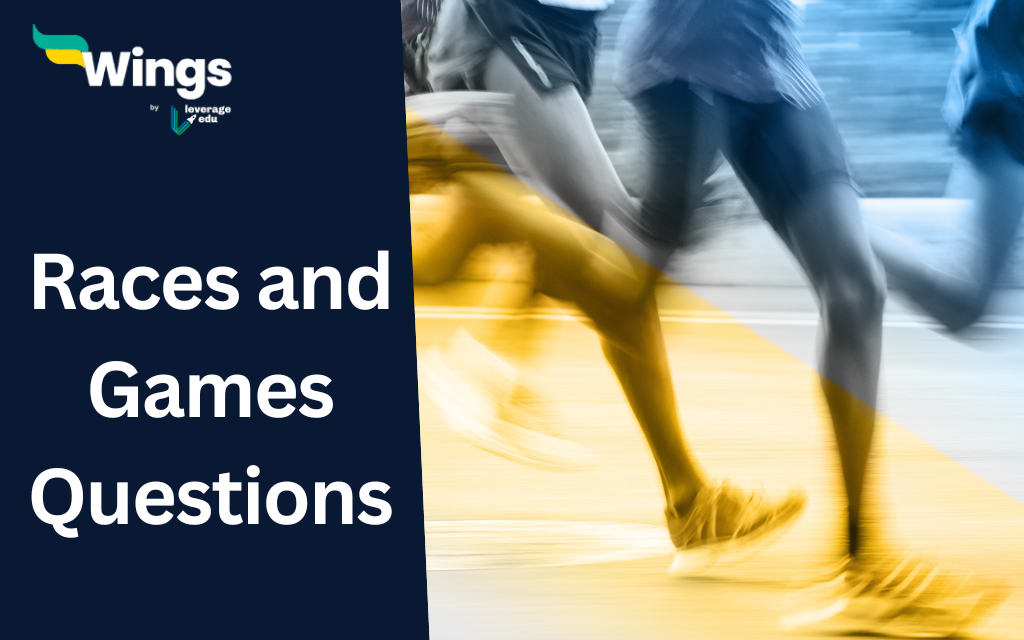The Races and Games are an important part of the quantitative aptitude section in the upcoming government exams.
Races and Games are asked in exams like:
Start your preparation by solving these questions. In this blog, we will review the fundamentals of Races and Games, the types of questions asked in previous year exams and how to approach them. This will help you clear your basics and answer these Races and Games.
What are Races and Games? What are Races and Games?
The Races and Games questions are based on the basic concept of Speed and Distance. The term “race” means what distance competitors cover in any activity in a given period.
All the formulae for calculating and solving these problems are based on the basic concepts of Time, Speed and Distance.
Here is the basic formulae:
- xn/(n-1) meters.
Must Read: 31+ Questions of Matching Definitions Reasoning with Answers
10 + Races and Games Questions and Answers
Question: 1 In a 500 m race, the ratio of the speeds of two contestants A and B is 3:4. If A has a start of 140 m, then A wins by
(A) 10 m
(B) 20 m
(C) 30 m
(D) 40 m
Ans: B
Question: 2: In a game of 100 points, A can give B 20 points and C 28 points. Then, B can give C.
(A) 8 points
(B) 10 points
(C) 12 points
(D) 14 points
Ans: B
Question: 3: In a kilometre race, A, B and C are three participants. A can give B a start of 50 m and C a start of 69 m. The start which B can allow C, is
(A) 16 m
(B) 18 m
(C) 20 m
(D) 22 m
Ans: C
Question 4: A and B can cover a 200 m race in 22 seconds and 25 seconds respectively. When A finished the race, then B is at what distance from the finishing line?
(A) 22 m
(B) 24 m
(C) 30 m
(D) 48 m
Ans: B
Question 5: A, B and C are three contestants in a km race. If A can give B a start of 40 m and A can give C a start of 64 m, how many metres start can B give C?
(A) 20 m
(B) 25 m
(C) 30 m
(D) 40 m
Ans: B
Question 6: In a 200 m race, A beats B by 35 m or 7 seconds, A’s time over the course is
(A) 40 sec
(B) 47 sec
(C) 33 sec
(D) None of these
Ans: C
Question 7: In a 100 m race covers the whole distance in 36 seconds and B in 45 seconds. In this race, A beats B by
(A) 20 m
(B) 25 m
(C) 22.5 m
(D) 9 m
Ans: D
Question 8: At a game of billiards, A can give B 15 points in 60 and A can give C 20 points in 60. How many points can B give C in a game of 90?
(A) 30 points
(B) 20 points
(C) 10 points
(D) 2 points
Ans: C
Question 9: In a 200 m race, A can beat B by 31 m and C by 18 m. In a race of 350 m, C will beat B by
(A) 22.75 m
(B) 25 m
(C) 19.5 m
(D) 13 m
Ans: B
Question 10: A can run 1 km in 3 mi 10 sec and B can cover the same distance in 3 min 20 sec. By what distance can A beat B?
(A) 20 m
(B) 30 m
(C) 40 m
(D) 50 m
Ans: D
Must Read: 50+ Verbal Classification Questions with Answers
FAQs
The basic formula for races and games is = xn/(n-1) meters.
To solve the race and game questions, the candidates need to use the formulae according to the situation given.
The quantitate aptitude section consists of race and game questions in different government examinations.
RELATED BLOGS
This was all about the “10 + Races and Games Questions and Answers”. For more such informative blogs, check out our Study Material Section, or you can learn more about us by visiting our Indian exams page.
 One app for all your study abroad needs
One app for all your study abroad needs














